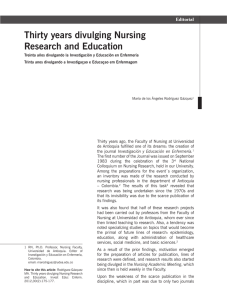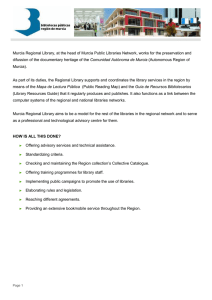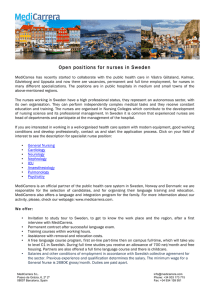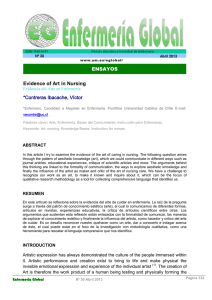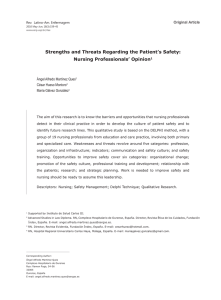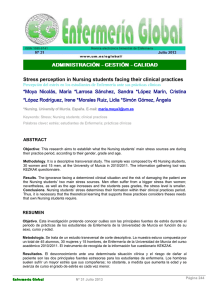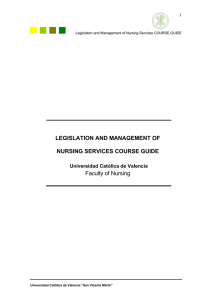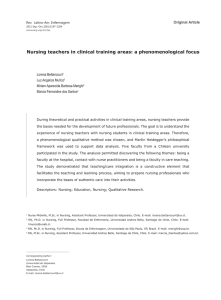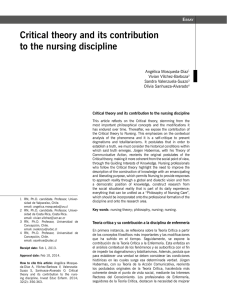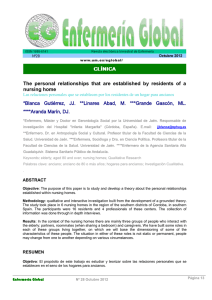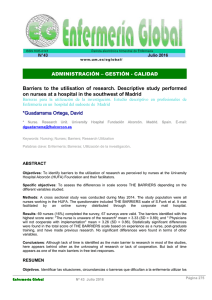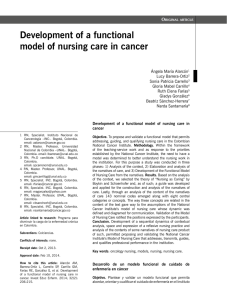Report of nursing at hospital
Anuncio
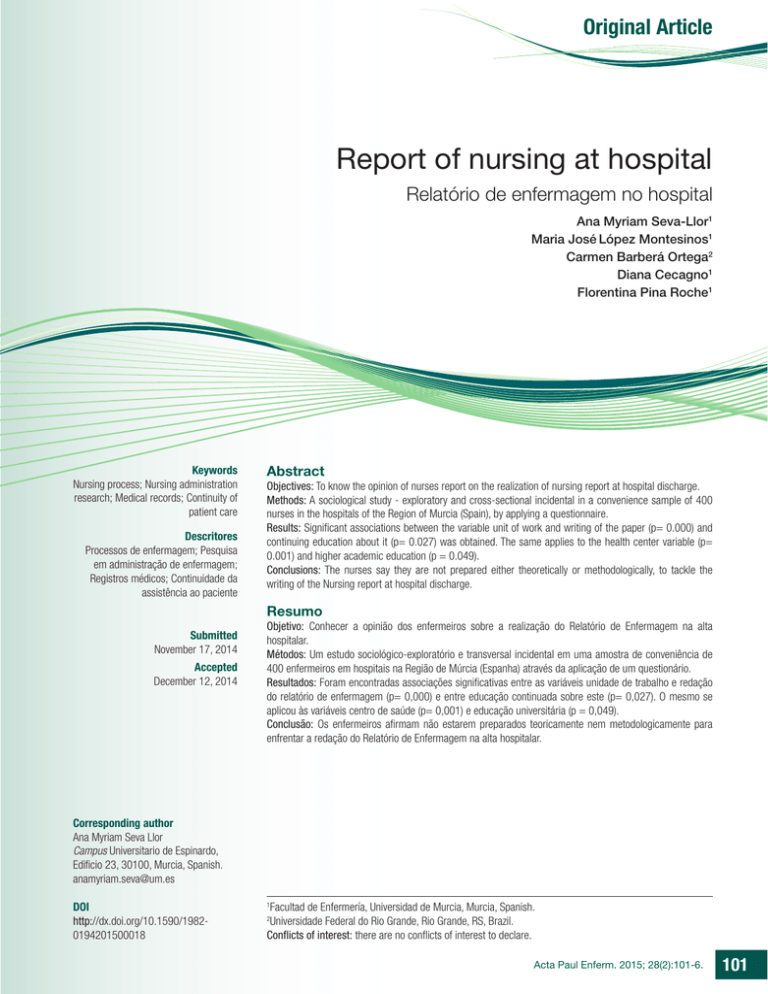
Original Article Report of nursing at hospital Relatório de enfermagem no hospital Ana Myriam Seva-Llor1 Maria José López Montesinos1 Carmen Barberá Ortega2 Diana Cecagno1 Florentina Pina Roche1 Keywords Nursing process; Nursing administration research; Medical records; Continuity of patient care Descritores Processos de enfermagem; Pesquisa em administração de enfermagem; Registros médicos; Continuidade da assistência ao paciente Abstract Objectives: To know the opinion of nurses report on the realization of nursing report at hospital discharge. Methods: A sociological study - exploratory and cross-sectional incidental in a convenience sample of 400 nurses in the hospitals of the Region of Murcia (Spain), by applying a questionnaire. Results: Significant associations between the variable unit of work and writing of the paper (p= 0.000) and continuing education about it (p= 0.027) was obtained. The same applies to the health center variable (p= 0.001) and higher academic education (p = 0.049). Conclusions: The nurses say they are not prepared either theoretically or methodologically, to tackle the writing of the Nursing report at hospital discharge. Resumo Submitted November 17, 2014 Accepted December 12, 2014 Objetivo: Conhecer a opinião dos enfermeiros sobre a realização do Relatório de Enfermagem na alta hospitalar. Métodos: Um estudo sociológico-exploratório e transversal incidental em uma amostra de conveniência de 400 enfermeiros em hospitais na Região de Múrcia (Espanha) através da aplicação de um questionário. Resultados: Foram encontradas associações significativas entre as variáveis unidade de trabalho e redação do relatório de enfermagem (p= 0,000) e entre educação continuada sobre este (p= 0,027). O mesmo se aplicou às variáveis centro de saúde (p= 0,001) e educação universitária (p = 0,049). Conclusão: Os enfermeiros afirmam não estarem preparados teoricamente nem metodologicamente para enfrentar a redação do Relatório de Enfermagem na alta hospitalar. Corresponding author Ana Myriam Seva Llor Campus Universitario de Espinardo, Edificio 23, 30100, Murcia, Spanish. anamyriam.seva@um.es DOI http://dx.doi.org/10.1590/19820194201500018 Facultad de Enfermería, Universidad de Murcia, Murcia, Spanish. Universidade Federal do Rio Grande, Rio Grande, RS, Brazil. Conflicts of interest: there are no conflicts of interest to declare. 1 2 Acta Paul Enferm. 2015; 28(2):101-6. 101 Report of nursing at hospital Introduction All steps of the Nursing Process (Assessment, Nursing Diagnosis, Planning, Implementation and Evaluation) should be integrated into the patient record system allowing communication between professionals of the healthcare team. The journal of nursing care to patients is an essential task both to provide adequate sanitary quality for the development of the profession.(1) Records of Nursing can be defined as “the supporting documentation where all information about nursing activity regarding a particular person in their valuation is collecting, treatment received and evolution.”(2) In addition to serving as a documentary record, may used for the benefit of the health center and staff, as well as defending against a legal action and an evaluation system for the management of nursing care. The registration of nursing practice in the clinical history of the patient involves a continuous update of the methodological and theoretical knowledge of the profession, and exchange of standardized information to all. Please ensure the planning and allocation of care through standardized taxonomies of NANDA, NIC and NOC diagnostics, and facilitate the application of nursing process in all its stages. Therefore, it can be an effective way to influence nursing practice, however, remains deficient and scarce.(3) Among the various records that manage nurses include the newest, known as nursing discharge report or, more recently, the Report of Continuing Care. The Report of the High Nursing is the document developed and written by the nurse at discharge, who has attended the patient during hospitalization.(4) Includes the fundamentals of nursing process for patient admission,(5) ensures the continuity of care,(6,7) facilitates the monitoring of patients(8) and clarifies the role of the nurse in the population it serves.(9) Another definition describes it as “the document closes the care process nurse initiated upon patient admission to a hospital, since communicating information about said patient between the two levels of support to our existing health care system.”(10) 102 Acta Paul Enferm. 2015; 28(2):101-6. The significance of this report is determined from the General Health Law of 1986 established healthcare in Spain on two interconnected levels of care: primary care (as a gateway for users to the system) and Care (as support and complement the primary care still needed for those processes whose complexity requires).(11) Since then, the continuity of care between the two levels has continued to be one of the main challenges that the various health services are being routinely face, with results so far quite discreet. Specific strategies proposed by experts we find nursing jobs report as a means of intercommunication, along with the creation of professionals as the liaison nurse, also called home nurse management, nurse or nurse case manager continuity, framed in case management programs. (11) Is the figure responsible for ensuring continuity of care, both among the various segments (medical, social services, other nurses, ...) and levels of support, therefore we can say that makes agent when the patient requires social and health services.(12) These circumstances influence directly the fact that nursing in Spain is a European leader since the 70s of last century, which encourages managers to investigate the contents nurses, applications and training with professional on document in order to further develop the discipline. It is therefore necessary to analyze the initial confrontation of clinical nurses in hospitals of the Region of Murcia to the immediate implementation of the realization of the Nursing report at hospital discharge. The goals we set in this paper are initially know their professional opinion (editorial, appropriateness and patient safety) and focus on identifying what the barriers they will encounter health managers when the time comes are work with the document (training, workloads, lack of time and professional relationships with other health groups). Methods We present a descriptive study - incidental to exploratory and cross-sectional approach. Performing first phase of literature review and subsequent field study, in which an analysis of qualitative and quan- Seva-Llor AM, Montesinos MJ, Ortega CB, Cecagno D, Pina Roche F titative variables using validated by nature hospitals under study adapted to the sample after analysis using pretest questionnaire was performed. The study population constitutes nurses Specialized Care in the Region of Murcia, located in hospitals in nine areas of health CCAA Murcia (Table 1). The sample was randomly selected among the professionals of the 9 hospitals in the Region of Murcia, belonging to 9 health areas of the region selected for the study. The final questionnaire was developed after a mandatory completion of a pilot, during the month of June 2010 with a sample of 100 pretest to nine hospitals in the region, and based on the contents methodology used in the SELENE platform(13) based on the Patterns Gordon.(14) Methods and tools used in all hospitals in the region of Murcia for the completion of the medical record and nursing and care management. Once collected and analyzed, the final model questionnaire, adapted to the subject target population of our study was designed. The final version includes 46 numerical questions, Likert scale or nominal dichotomous response (yes / no), divided into blocks that include occupational, sociodemographic questions college / continuing education and 4 specific questions related to knowledge and use of language professional standard, object of study of this work. The sample size calculation was performed with the program GRANMO, with a confidence level of 95%, giving a final sample of 400 questionnaires. 530 questionnaires were distributed along with a presentation of the study generally, during the months of November and December 2010 and January 2011, including nine hospitals in the relevant areas of health in the Region of Murcia. Along with a presentation of the study questionnaire was attached in general, ensuring at all times the confidentiality and anonymity of the data collected, and counting with the collaboration of professionals from the center, responsible for each of the units. Inclusion criteria: nurse active in the centers studied at the time of research and welfare functions. Exclusion criteria: nurses who were not active at the time of completing the questionnaire. Variables under study: demographic and socio independent variables, and application dependent variables measuring dimensions that allow us the scope of study objectives: the nurse in relation to the Report to the Upper view of Nursing and the potential difficulties implantation. For the descriptive analysis, measures of central tendency and frequency percentage was used. The association of quantitative variables was performed using Student t, Chi square used for the measurement of qualitative variables. Univariate and multivariate analyzes were performed, adjusting the model for length of job. Using the statistical software package SPSS (Statistical Package for Social Sciences) version 19.0 for Windows, and the creation of a database of our variables, was performed the statistical analysis thereof. The development of this study met national and international standards of ethics in research involving human subjects. Table 1. Studied hospitals and number of nurses surveyed Health areas/Murcia I: Murcia/Oeste Hospitals Surveys Surveys null (not answered correctly, or not returned) Nurses surveyed Hospital Virgen de la Arrixaca 180 62 118 Hospital Santa María del Rosell 40 18 22 Hospital Rafael Méndez 40 21 19 Hospital Comarcal del Noroeste 40 5 35 V: Altiplano Hospital Virgen del Castillo (Caravaca de la Cruz) 40 0 40 VI: Vega Media del Segura Hospital General Universitario Morales Meseguer 50 0 50 VII: Murcia/Este Hospital General Universitario Reina Sofía 50 0 50 VIII: Mar Menor Hospital Los Arcos 50 18 32 Hospital de la Vega Lorenzo Guirao (Cieza) 40 6 34 530 130 400 II: Cartagena III: Lorca IV: Noroeste IX: Vega Alta del Segura Total Acta Paul Enferm. 2015; 28(2):101-6. 103 Report of nursing at hospital Results In terms of “socio-demographic and socio data”, the age of nurseys respondents between 25 and 61 years, with a mean age of 37.24 years. There is a predominance of females (76.8%) compared to men (23.2%). The flagship service is the internal medicine unit with 30.3% (n = 121), followed by surgical units with 24.8% (n = 99), appearing last outpatients with 0, 5% (n = 2). Regarding the variable workload 64.8% (n = 259) of the nurses considered not adequate nurse staffing in the service where they work. The set of questions related to the professional opinion regarding the conduct of a Report of Nursing at Hospital reveals firstly that 71.8% (n = 287) of nurses surveyed expressed “agree” with preparing the Nursing report at hospital discharge and allows the continuity of patient care for 89.8% (n = 359) of the surveyed sample. Moreover, its performance would influence better patient monitoring by nurses, nurses for future interventions in 92% of cases. When the patient is discharged by your physician, 56.5% of professionals (n = 226), says writing it, stating, however, not to draw up a 74.8% (n = 299) of nurses surveyed when a patient is transferred to another department within the same hospital. In relation to whether once drafted, if delivery or on paper, 42.3% (n = 169) of respondents state that they deliver the patient or his family and does not deliver 27.8 % (n = 111). A 30% (n = 120) did not answer. Regarding the demonstration of academic level in the document, for 60% (n = 240) of the professionals surveyed report the realization of Nursing report at hospital discharge serves to highlight the current academic level of nursing. And 89% (n = 356) considered as an indicator of patient safety with which avoid future complications and adverse effects. Comparison of distributions made by ChiSquare test shows significant differences between variable, review the Nursing report, and the unit of work (χ2 = 50.145; p = 0.012), and also with the ratio nurse / patient (χ2 = 17.142; p = 0.000). 104 Acta Paul Enferm. 2015; 28(2):101-6. The block of questions focused on aspects that hinder the implementation of the Report of Nursing discharge in the Region of Murcia, first shows that 68.8% of respondents believed that professionals need specific training on the Nursing report. Loads of work in hospital units hamper the completion of a high nurse to report 81% (n = 324), and 86% of the sample consider difficulty completing the document if you subtract time for the rest nursing activities in his shift. The relationship between the nursing and other health professionals would be an inconvenience for the report, as manifested by the nurses. The professional relationship between the nurse and the doctor would not affect 69% (n = 276), or be impeded by the professional relationship with the nursing assistants, 92% of cases (n = 368) or with other health professionals (social workers and physiotherapists) in 82.8% (n = 331) of respondents. Also found statistically significant differences by Chi-Square between the “training in the Report” and the work unit (χ2 = 27.282; p = 0.027), and between temporary difficulty completing the document and the unit work (χ2 = 42.666; p = 0.000). The establishment of the crossing of the variables age group and the difficulty of writing the report of the High Nursing shows that 82.8% of professionals recognized that would be hard to make the report, especially those with who ranged in age between 21 and 34 years (88.3%). Discussion The results of our study we have known professional opinion and bias on the applicability of this document monitoring and care feedback. Local studies in different areas of health including health systems in various Spanish (Spanish Valencian Health Service, Spanish Cantabrian Health Service, etc.). Similar results are also obtained. Over 90% of respondents always considers its development is necessary before a small percentage who denies and also usually coincides with seasoned professionals in their jobs.(15) Similar figures are reflected when considering their usefulness and relevance, and also that 24% of pro- Seva-Llor AM, Montesinos MJ, Ortega CB, Cecagno D, Pina Roche F fessionals express agreement be in order, a finding consistent with the several difficulties reported in the literature (16,17) when directions of Infirmary decided to begin mandatory this document. Another point to note is that in units where there is a disproportionate nurse / patient ratio, the professionals do not write the Nursing report. Being on the other hand the ICU, the service where they are experimenting with the content, format and document models.(18) It is important that patient safety indicators required to follow good practice among those who are “reasoned the existence of standards for nursing staffing”(19) and this is not being met, as revealed by our data. Continuity of care in the Murcia region reaches its maximum level with the launch of the “Single Management”, starting January 2010. Consider patient care as a longitudinal process without compartments and an integrated healthcare provision is defined by the disappearance of the barriers hitherto existing between primary care and specialized care.(20) The pilot began in the areas of health Yecla Murcia towns first, and Lorca later, coming soon to other areas health of the Region of Murcia. That same year he succeeded in passing the Royal Decree 1093/2010, of September 3, wherein the minimum set of data from clinical reports in the NHS and in which dutifully develops the Care Report defined Nursing through its Annex VII.(21) Since June 2012 the Spanish Health System assumes that the quality of care involves the appropriate use of resources and technologies, and to ensure sustainability, security, continuity of care, equity and social participation, managers have focused their strategy in Addressing the chronicity.(22) This measure is justified by the changing needs of health and social care that cause aging population, increasing becoming chronic health conditions and limitations in activity in today’s society. The Region of Murcia is in the process of implementation of the document at the regional level to soon have it spread across the country, and each area of Health uses its own document model. For it is essential that the collective nurse initially made the report to all patients seen at hospital discharge, and not just focus on completing it in those patients in certain chronic medical conditions. This mistake can have negative consequences on the development of clinical management nurse. One of the first we met, is already the name by which we mean the document. Its nomenclature continues at this time without being widespread. Following the literature review, we met with various denominations of the paper, referring to him as Report of care at discharge, discharge report nursing assessment report discharge nursing registration nursing discharge the patient, report recommendations to nursing discharge report or Continuity of Care (ICC). Opt instead for CHF Nursing Report High may suppose ourselves to confusion if we seek to develop the profession. The next element to improve and standardize its structure, research topics for subsequent research. Conclusion The nursing profession in the Region of Murcia manifested not be prepared either theoretically or methodologically to complete the Nursing report at hospital discharge recognizing that requires specific training to deal with the registration of care in the document. Furthermore, the identified variables that directly impede the realization of the report have been the health center, hospital unit where the daily work and university academic training nurses have developed. Collaborations Seva-Llor AM; Montesinos MJL; Ortega CB; Cecagno D and Pina Roche F contributed to the project conception, relevant critical revision of the intellectual content, research development and data interpretation, drafting and final approval of the version to be published. References 1. García Ramirez S, Navío Marco A , Valentín Morganizo L. Normas básicas para la elaboración de los registros de enfermería. Nure Investigación [Internet]. 2007; 28:1-8. [Acceso 2014 Jun Acta Paul Enferm. 2015; 28(2):101-6. 105 Report of nursing at hospital 14]. Disponible en: http://www.nureinvestigacion.es/ficheros_ administrador/protocolo/pdf_protocolo28.pdf.Jiménez JC, Cerrillo D. Registros de enfermería: un espejo del trabajo asistencial. Metas de enfermería. 2010; 6(3):8-11. 2. Currell R, Urquhart C. Sistemas de registro de enfermería: efectos sobre la práctica de la enfermería y resultados en la asistencia sanitaria (Revisión Cochrane traducida). En: La Biblioteca Cochrane Plus [Internet]. 2008 (4). Oxford: Update Software Ltd. [Acceso 2014 Nov 12]. Disponible en: http:// www.update-software.com. (Traducida de The Cochrane Library, 2008 Issue 3. Chichester, UK: John Wiley & Sons). 12.Sánchez Ros N, Reigosa Gago LF. SELENE. Informatización de la historia clínica electrónica: implicación sobre el proceso de enfermería. Enferm Glob. 2006; 5(8):1-10. 13. Gordon, M. Pasado, presente y futuro de los diagnósticos de Enfermería. Cult Cuid. 2000; 7:128-38. 3. Lucendo A, Noci J. El informe de alta de enfermería, un instrumento para la continuidad de los cuidados. Enferm Clín. 2004; 14(3):184. 14. Chica Fernández M J, Costa Ruiz, A, Rodríguez Villagordo M J, Sánchez Salmerón A, Torres Gómez J F. Informe alta enfermería: historia clínica integral. Enfuro. 2012; (122):19-24. 4. Del Olmo SM, Casas L, Mejías A. El registro de enfermería: un sistema de comunicación. Enferm Clín. 2007; 17(3):142-5. 15. Egea González SC, Bravo Esteban AM. Opinión y realidad del informe de alta de enfermería en el Servicio de Urología. Enfuro. 2007; (104):6-10. 5. Ruiz MC. Utilización del diagnóstico enfermero en los informes de enfermería al alta hospitalaria [Internet]. Biblioteca Lascasas; 2005. [Acceso 2014 Jun 12]. Disponible en: http://www.index-f.com/ lascasas/documentos/lc0012.pdf. 16. Merino-Ruiz M , Sebastián-Viana T, Gómez-Díaz MC, Leo del Castillo Y. Utilidad y dificultades para la realización del informe de enfermería al alta hospitalaria según las enfermeras del Hospital de Fuenlabrada. Enferm Clín. 2008; 18(2):77-83. 6. Ubé Pérez JM, Urzanqui Rodríguez M, Rodríguez Herce C, Blasco Ros M, Ascarza Rubio S, Musitu Pérez V. Evaluación de la relevancia del informe de enfermería al alta hospitalaria por el usuario interno y externo. Nure Invest. 2006; 24:1-23. 17. Navarro Arnedo JM Orgiler Uranga PE, Haro Marín S de. Nuevo informe de alta de enfermería de cuidados intensivos: grado de satisfacción y cumplimentación de los colectivos implicados. Enferm Clín. 2006; 16(4):190-7. 7. Grupo de Enfermería Gestora de Casos Hospitalaria de Granada. Relevancia del contenido y transmisión del Informe de Enfermería al alta hospitalaria. Evidentia [Internet]. 2011; 8(36). [Acceso 2014 Nov 8]. Disponible en: http://indexf.publicaciones.saludcastillayleon.es/ evidentia/n36/ev7623.php. 18. Saturno PJ. Análisis de la cultura sobre seguridad del paciente en el ámbito hospitalario del Sistema Nacional de Salud español. Madrid: MSC; 2008. 8. Caamaño C, Sáinz A, Martínez JR, Alonso M, Carro J. Evolución y valoración de la calidad del informe de enfermería al alta. Rev Calid Asist. 2004; 19(6):396-401. 9. Macía ML, Rueda RM, Garrido MA. Utilidad de un modelo práctico de informe urológico de enfermería al alta hospitalaria. Rev Asoc Enf Urología. 1996; 60:6-7. 10. Sevilla, F. La Ley General de Sanidad: el impulso necesario. Rev Adm Sanit. 2007; 5 (3):407-25. 106 11.Jódar-Solà G, Cadena-Andreu A, Parellada-Esquius N, MartínezRoldán J. Continuidad asistencial: rol de la enfermera de enlace. Atenc Primaria. 2005; 36(10):558-62. Acta Paul Enferm. 2015; 28(2):101-6. 19.Consejería de Sanidad y Política Social. Sanidad apuesta por las gerencias únicas para mejorar la coordinación entre centros de salud y hospitales [Internet]. 2011. [Acceso 2014 Jun 14]. Disponible en: http:// www.murciasalud.es/noticias.php?op=ver&id=172032&idsec=66. 20.Seva-Llor AM. El conjunto mínimo de datos de los informes clínicos. Enferm Glob. 2010; 19(1):1-2. 21. Nuño R, Toro N. Estrategias de abordaje de la cronicidad en el SNS: una innovación cuyo tiempo ha llegado. Economía y Salud: 2013;76:6-8. 22. Martínez L, Cantero M L. Informe de cuidados en enfermería: revisión de su situación actual. Enferm Glob. 2013; 12(32):336-45.
